Singapore Champions Robotics Adoption And Talent Development With New Open-source Initiatives
NRP and partners announced new initiatives at ROSCon 2025 — held in Singapore for the first time

Mr Tung Meng Fai, Executive Director, National Robotics Programme (NRP); Professor Tan Chorh Chuan, Chairman, Agency for Science, Technology and Research (A*STAR); Ms Vanessa Yamzon Orsi, CEO, Open Source Robotics Foundation; and Dr Wang Wei, Deputy Executive Director (R&D) at A*STAR SIMTech and A*STAR ARTC, attended ROSCon on 28 October 2025.
SINGAPORE - The National Robotics Programme (NRP), together with partners, has announced a suite of new initiatives to advance robotics adoption and build a future-ready robotics workforce.
The new initiatives include the set-up of a shared testbed, a new collaboration and national standards to advance robot interoperability, and a programme to strengthen talent development.
The announcements were made at ROSCon 2025, the world's leading developer conference for open-source robotics, hosted in Singapore for the first time by the Open Source Robotics Foundation (OSRF). The event brings together developers, researchers, and industry leaders from around the world to share advances in the Robot Operating System (ROS) and Open-RMF, the open source implementation of Robotics Middleware Framework (RMF) - key technologies that lay the foundation for robotics development worldwide.
These initiatives reflect Singapore's growing role as a global testbed for open and interoperable robotics, uniting public agencies, research partners and companies to translate innovation into scalable, real-world solutions.
“Through open collaboration and shared infrastructure, Singapore is helping industry partners deploy robotics faster, safer, and more widely. It is encouraging to see the Robotics Middleware Framework, which originated from Singapore, now proliferating globally as Open-RMF and creating impact across industries. These latest initiatives reinforce Singapore's role as both a contributor to the global open-source community and a hub for robotics adoption,” said Mr Tung Meng Fai, Executive Director, NRP.
Creating testbeds for RMF
The RMF was first catalysed by NRP in 2018 and developed locally with partners Changi General Hospital (CGH), Centre for Healthcare Assistive and Robotics Technology (CHART), Synapxe, HOPE Technik, and Open Source Robotics, becoming the world's first standard platform for robotics interoperability.
Built on ROS, a set of software libraries and tools that help developers build robot applications, RMF enables robots and systems from different manufacturers to work together seamlessly. It reduces repetitive integration work and helps robotics adopters and companies deploy robots more safely and efficiently. RMF is already in use in major facilities such as the CGH and the Changi Airport (see Annex A for examples).
To enable safer and faster deployment of robots in shared environments, NRP, together with the Public Sector Science and Technology Policy and Plans Office (S&TPPO), the Agency for Science, Technology and Research (A*STAR), and the Building and Construction Authority (BCA) announced the establishment of the ELEVATE1 @ BCA Braddell Campus — a national sandbox for RMF.
This sandbox provides both a physical and virtual test environment for collaboration. It enables end-users, Original Equipment Manufacturers for robots and infrastructure, and system integrators to come together and validate how robots, lifts and building systems interact in facilities management using Open-RMF. It will be the first of several sectoral sandboxes planned to drive RMF adoption across industries.
Local partners are invited to participate in the sandbox at ELEVATE @ BCA Braddell Campus, to foster wider adoption and collaborative development of RMF. Several leading companies, including Black Sesame Technologies, Delta Electronics, HOPE Technik, KABAM Robotics, LionsBot, MEGAZO Technologies, Panasonic, and SIMPPLE are the first participants of the sandbox.
To strengthen international collaboration, the A*STAR Advanced Remanufacturing and Technology Centre (A*STAR ARTC) and the OSRF signed a Memorandum of Understanding to co-develop best practices, guidelines and testing plans for RMF as it relates to open source robotics, using the sandbox at ELEVATE @ BCA Braddell Campus as a reference site. The partnership will also focus on ecosystem growth through roadmap development and community engagement.
“Our collaboration with the Open Source Robotics Foundation (OSRF) underscores A*STAR's commitment to advancing open, interoperable technologies. By combining A*STAR's technical expertise with OSRF's global experience, we aim to further develop the Open-RMF as a universal framework for robot interoperability and accelerate robotics adoption across industries. This partnership exemplifies A*STAR's mission to translate research into real-world impact," said Dr David Low, Chief Executive Officer, A*STAR ARTC.
Establishing two national standards for safer robot interoperability
To support safe and scalable robotics adoption, Singapore's two new national standards for robot interoperability - Singapore Standard (SS) 713: Data Exchange Between Robots, Lifts and Automated Doorways and Technical Reference (TR) 130: Interoperability Between Robots and Central Command Systems - were showcased at ROSCon 2025.
The SS 713 and TR 130 were developed by robotics working groups, overseen by the Manufacturing Standards Committee under the purview of the Singapore Standards Council. These working groups co-convened by CHART and HOPE Technik, comprising of government and industry stakeholders, established clear guidelines governing how robots should communicate with lifts, automated doorways, building systems, and central command systems.
SS 713, which focuses specifically on building infrastructure integration, offers a unified protocol for standardised robot operations in complex facilities. Companies aligned with this standard will be able to demonstrate readiness to facility operators. Efforts are underway to elevate SS 713 to the international ISO level, setting a global benchmark for robotic communication with facility systems worldwide.
Building a future-ready robotics workforce
To strengthen Singapore's robotics talent pipeline, the ROS-Industrial Consortium Asia Pacific (ROS-I AP), led by A*STAR ARTC, and SGInnovate launched the ROS-Industrial Train-and-Place Programme on Deep Tech Central. This programme builds on an earlier partnership between ROS-I AP and seven Institutes of Higher Learning, which focused on nurturing a baseline competency of ROS-related capabilities that the industry can rely on, through harmonising students' learning outcomes and improving their ROS capabilities.
The latest collaboration between ROS-I AP and SGInnovate will emphasise industry placement, leveraging SGInnovate's ecosystem connectivity and talent development programmes to connect talent directly with robotics companies such as AiTreat, Fabrica AI, Griffin Labs, Hivebotics, and Vilota.
By equipping trainees with hands-on experience and connecting them with deployment opportunities, the programme helps address the talent gap in robotics and embodied AI and builds a pipeline of ROS-trained talent. The data and insights generated from Deep Tech Central will also enable a deeper understanding of robotics talent needs and industry demand, strengthening the capabilities of Singapore's robotics ecosystem while contributing to the wider global robotics community.
- End -
1 ELEVATE stands for EvaLuatE, VAlidate, Test Environment.
Enclosed:
Annex A - Examples of RMF applications
Annex B - Quotes from NRP's partners
About the National Robotics Programme
The National Robotics Programme (NRP) is a multi-agency national programme hosted by the Agency for Science, Technology and Research (A*STAR), that oversees the research, development and translation of robotics enablers and solutions in Singapore. Established in 2016 as part of the RIE (Research, Innovation and Enterprise) initiative, NRP aims to catalyse differentiated robotics capabilities in Singapore through the funding of use-inspired research and use-driven development. NRP also leverages the projects it funds to grow our robotics talent pool and nurture a vibrant local ecosystem.
For more information, visit the NRP LinkedIn page.
ANNEX A - Examples of RMF applications
The Robotics Middleware Framework (RMF) enables robots and systems from different manufacturers to communicate with one another and operate seamlessly. They are already in use in facilities such as the Changi Airport and healthcare institutions.
Our partners currently using RMF include:
Changi Airport Group
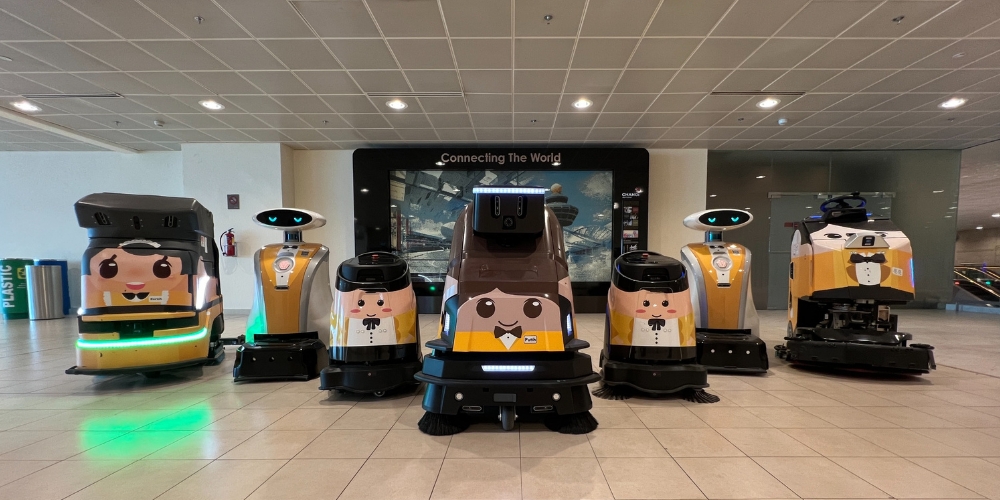
Photo of Changi Airport Group's fleet of cleaning Robots
At Changi Airport, one of the world's busiest air hubs, robots help maintain terminal cleanliness and efficiency. The RMF coordinates these diverse cleaning fleets and enables them to operate seamlessly within the airport's large and complex environment.
Through RMF, cleaning tasks are managed and assigned in real time. Cleaning efficiency is optimised with the dynamic adjustment of cleaning schedules based on flight data to avoid peak passenger traffic.
Looking ahead, RMF will enable Changi Airport Group to further improve operational efficiency across various domains. Future applications could include deploying robots for passenger service, safety checks, and logistics coordination.
Changi General Hospital
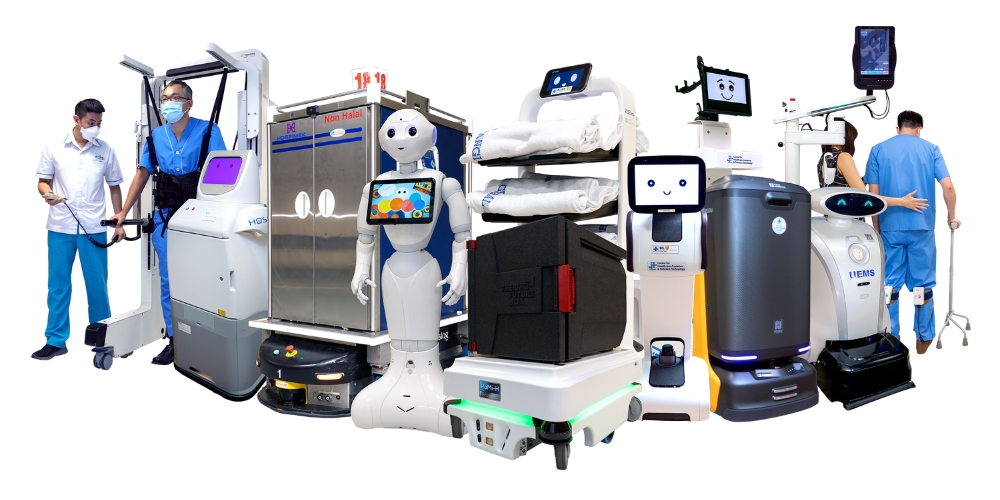
Changi General Hospital has over 80 robots as part of the hospital's smart care team, each one tasked to optimise workflows for greater efficiency and accuracy, and contribute to enhanced patient care.
Spearheaded by Changi General Hospital (CGH), the Centre for Healthcare Assistive and Robotics Technologies (CHART) was established with the aim to transform care delivery and optimise rehabilitation. It enables the co-development and test bedding of healthcare solutions in assistive technologies and robotics.
During COVID-19, CGH-CHART deployed RMF within two weeks to manage diverse robots providing cleaning, delivery, and teleconsultation services at national isolation facilities at EXPO, supporting the hospital's healthcare workforce in caring for the community. The experience also helped other public sector hospitals across the healthcare clusters to adopt and deploy robotics.
In 2022, CHART launched the Robotics Middleware for Healthcare (RoMi-H) with its partners Synapxe and engineering firms HOPE Technik and Open Source Robotics. RoMi-H allows interoperability with other robots performing more urgent tasks. For example, a robot transporting a sick patient would take priority over a droid delivering linens. Supported by NRP, CHART is currently working on an improved version of RoMi-H with enhanced capabilities enabling integrated and interoperable modular robotics to operate in dynamic environments, centred around patients.
“We are proud that RMF, which CGH and our partners first started as a solution for healthcare, has become a gamechanger in interoperable systems, accelerating the integration of automation and robotics in Singapore and the world. We are also heartened that RMF continues to create new value that benefits not just patients and healthcare professionals, but also much wider communities and across industries,” said Clin Prof Ng Kee Chong, Chief Executive Officer, Changi General Hospital.
Annex B - Quotes from NRP's partners
- Jonathan Cheng, Chief Technology Officer, Building and Construction Authority (BCA):
"BCA is glad to be able to host the multi-agency ELEVATE @ BCA Braddell Campus. It is the home of the Built Environment Innovation Hub - a sandbox and collaborative space to connect like-minded individuals, showcase innovative technologies and facilitate the transfer of ideas and knowledge to accelerate the transformation of the Built Environment sector. We look forward to working with various stakeholders to drive the development of Open-RMF to enhance systems interoperability and translate into real-world practical solutions." - Vanessa Yamzon Orsi, CEO, Open Robotics:
“Having closely worked with the various agencies in the robotics ecosystem in Singapore in preparation for ROSCon this year, I am privileged to have seen up close how the various stakeholders in the community work together, and how they value cross-agency collaboration in order to advance the country's shared goals for robotics and technology. On behalf of Open Robotics, I would like to thank my colleagues in Singapore for all your work on behalf of the robotics community. There is no doubt that Singapore will continue to be at the forefront of innovation and advancement in our field.” - Jae Annie Tay, Director - People at SGInnovate:
“Our partnership with ROS-Industrial Consortium Asia Pacific on the ROS-Industrial Train-and-Place Programme exemplifies SGInnovate's commitment to building a robust robotics talent pipeline. By leveraging Deep Tech Central to connect industry, academia, and talent, we are aligning skills with real-world demand and using data-driven insights to shape the future of Singapore's robotics ecosystem.”
A*STAR celebrates International Women's Day
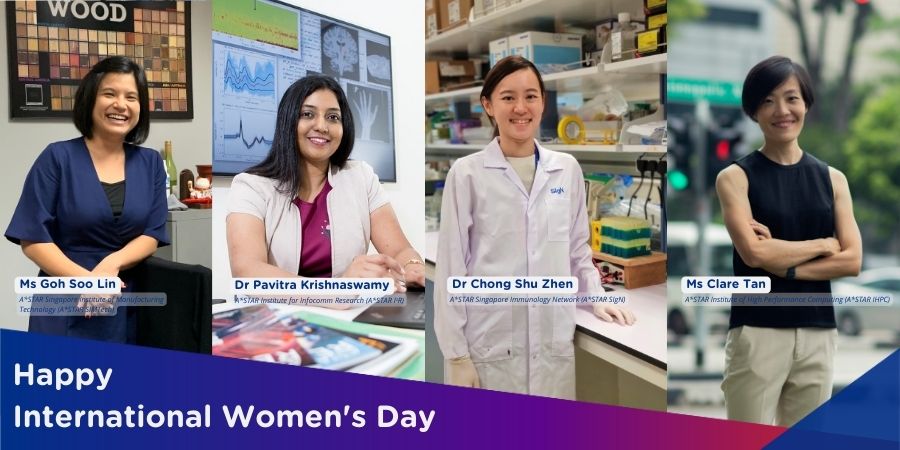
From groundbreaking discoveries to cutting-edge research, our researchers are empowering the next generation of female science, technology, engineering and mathematics (STEM) leaders.
Get inspired by our #WomeninSTEM
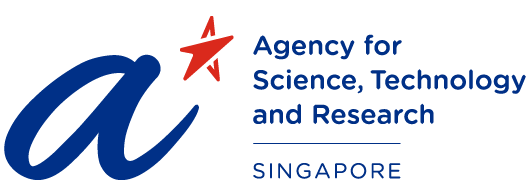


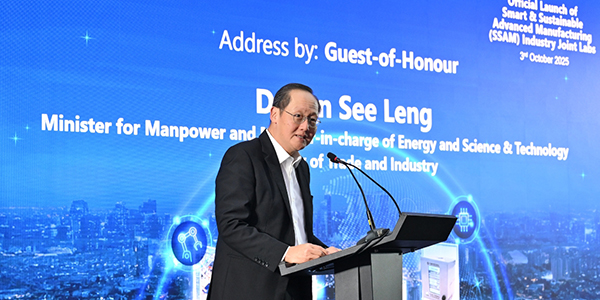
---doris-yang-(1).jpg?sfvrsn=7755bc2b_1)